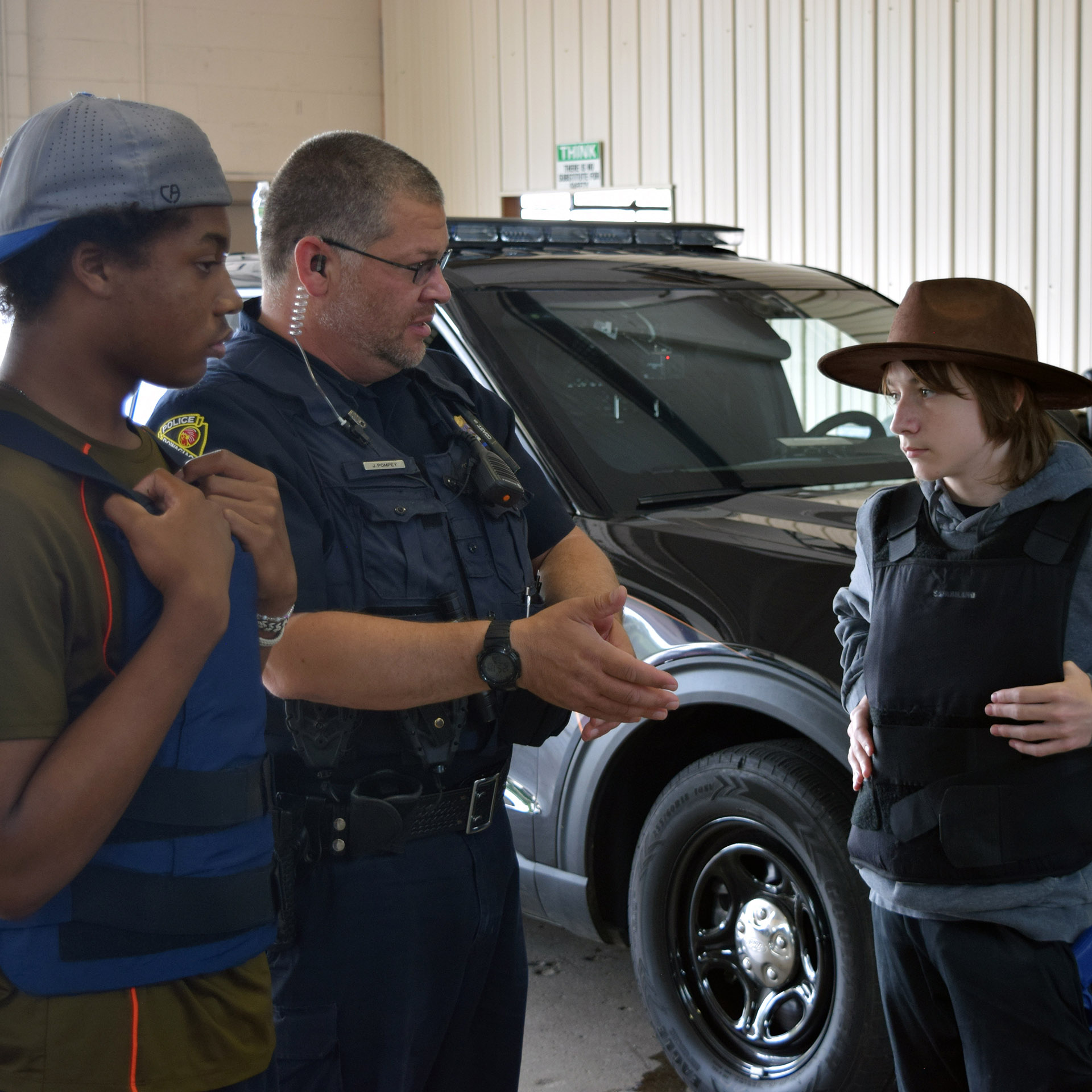
News
Nine ETS Students Finish Police, Fire Training
Published on July 29, 2024 - 1 p.m.
Southwestern Michigan College Educational Talent Search (ETS), in partnership with the Dowagiac fire and police departments, July 22-26 offered simulated fire and police training.
Public Safety Camp is meant to inform students about the important role fire and police departments play in community protection.
Teamwork is an essential component. Nine students worked in groups during the week-long camp, including stuffing 100 school-supply backpacks on Tuesday that will be distributed Aug. 6 at National Night Out.
Students trained for and had the chance to put out an actual fire. High school students were also exposed to a variety of careers in the public safety realm.
Participants included: Baylee Bauman, Brandywine; Jaden Ciszczon, Ossian Duckworth and Steven Solorek, Edwardsburg; Amari Gaston, Alayna Rogalski and Skyler Solomon, Dowagiac; and Skielynn Snodderly and Serenity Singleton, Marcellus.
Eleven-year Public Safety Director Steve Grinnewald, a 34-year law-enforcement veteran, oversees both departments.
Campers also met deputy chiefs Kevin Roman, the police department’s canine handler of Cash, and Tony Stewart of the fire department.
Stewart showed damage the ladder truck sustained helping Sister Lakes battle May’s Ramona Roller Rink fire. A blast of intense heat when the building collapsed melted its passenger-side lights.
The current 2011 station on Wolf Street will be replaced in four months by a new home under construction in the industrial park.
The DPD has 12 sworn officers, one civilian administrative assistant — SMC graduate Michell Outlaw — and three crossing guards.
Eight officers assigned to the patrol division work 12-hour shifts so there are always two officers on duty 24 hours a day, seven days a week, 365 days a year. The department has three officers assigned to the Cass County Drug Enforcement Team, or CCDET. Cash and retired K9 Tole live with Roman.
Cash, from Alabama, is a 4-year-old, 85-pound Belgian Malinois in perpetual motion except to sit long enough to fix Roman with an adoring look. Tole, 10, is a “more chill” black-and-tan German Shepherd from the Netherlands.
“I’m not a dog guy,” Officer Corey Smith said. “There’s no way I wanted to be around (Cash), but he’s very friendly.”
“Cash is a very good tracking dog,” Roman said. “He’s located 11. Where we smell pizza, dogs don’t layer smells like that. They have the ability to separate every single ingredient.”
Cash’s bite is worse than his bark — 1,400-1,800 pounds per square inch, which nearly cost a resisting offender his finger.
Cash has $2,500 ballistics- and stab-resistant body armor to wear courtesy of Spike’s K9 Fund. Founder Jimmy Hatch, a retired Navy SEAL, spoke at SMC in September 2017.
“There’s also a county warrant service team,” Grinnewald said. “A SWAT team, basically. We have three officers assigned to that with the sheriff’s office and tribal police. Our department contracts with SMC to provide security. We also have a school resource officer.”
Grinnewald talked about blue vests patrol officers must wear and 30 pounds of equipment carried, such as tasers opposite their gunbelt holsters, extra ammunition magazines, handcuffs, pepper spray, radio, flashlight, a tool that is both pliers and knife, gloves, a tourniquet and collapsible baton.
“I have a plate under my shirt,” he thumps his chest. “There’s no such thing as a bulletproof vest. It won’t stop everything.”
Tuesday afternoon, as campers prepared to practice traffic stops with Sgt. Jason Pompey, Grinnewald shared the police perspective.
“A lot of people have a misconception when they see us pull people over,” the chief said. “We don’t know if they’re running late or just killed someone. The Oklahoma City bomber, who killed 168 people, including 19 kids, was caught in a traffic stop because he didn’t have a license plate on his car. Most of the time, it’s nothing, but we have no clue what we’re walking into so our mindset is be prepared for anything.”
“Traffic stops are the most dangerous thing we do,” agreed Pompey, who fulfilled that role exclusively for 12 years. “I ask to see your license and registration. Upon request, by law, you are required to produce that or it’s a misdemeanor. Then I say I stopped you for A, B or C. This person knows where they’ve been and what they’ve done. I do not.”
Wednesday campers visited Niles Fire Department to experience the 100-foot aerial tower and for confined space training.
Thursday campers extinguished three vehicle fires with mutual aid from Sister Lakes and Wayne Township before MedFlight’s helicopter touched down after a nine-minute flight from Elkhart at 130 mph and two “orbits” of the landing site.
Students met civilian pilot Ron Vasconcelos, paramedic Rob Rose (Army veteran recently retired from South Bend Fire Department after 23 years), afraid-of-heights, 18-year flight nurse Raenelle Hamilton (Army veteran) and Ellsie, an EMT doing a ride-along.
“We carry blood and we can do some surgical procedures, either midair or on the ground,” Rose said. “We’re a flying ER/ICU. We can’t fly anywhere near lightning or icing conditions. We’ve transported patients separated from their arms, legs, feet, hands, but not organs. Harvest teams do that in fixed-wing aircraft.”
“We can start IVs,” Stewart said, “but our ambulances don’t carry blood.” The helicopter’s utility in locating missing persons has been supplanted by cheaper drones.
“We carry 200 gallons of fuel and burn 1.2 gallons a minute,” Rose said. “Raenelle and I have flown as far as Cleveland Clinic, Mayo Clinic (Minnesota), St. Louis, Pittsburgh, Indianapolis and Chicago.”
Camp concluded Friday touring South Bend’s Luther J. Taylor Sr. Fire Training Center.











